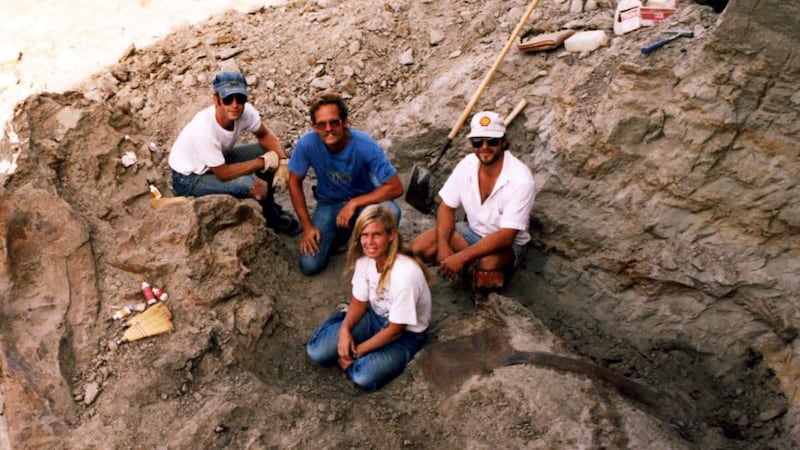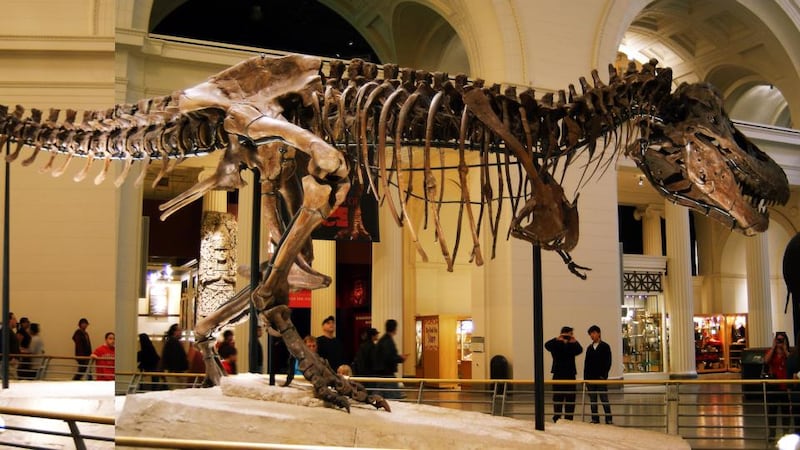Never mind those super-beings in leotards or those cars that turn into robots, the most admirable movie hero of the summer might just be a softly spoken, sexagenarian palaeontologist from South Dakota.
Todd Douglas Miller's Dinosaur 13, among the year's very best documentaries, tells how, in 1990, Peter Larson and his team from the Black Hills Institute unearthed an unusually well-preserved Tyrannosaurus rex specimen on Native American land. We watch as the fossil hunters locate claws, ribs and a damaged skull. Named Sue, after Sue Hendrickson, one of Larson's colleagues, the beast turned out to be the most complete T rex fossil yet found.
This ought to have been an almighty triumph for Larson and his family. Having collected fossils since childhood, the clan had long dreamed of locating this class of signature find.


“It was her completeness,” Larson says. “She’s a living entity for me. She’s not a pile of bones. And there’s something very special about her. There’s a lot of things she has already taught us. And there are still so many secrets located in those bones. There’s something really special about your first love.”
Sadly, the story rapidly turned into a potage of tragedy and farce. The FBI and the National Guard descended upon the institute and hauled off the huge fossilised remains. Larson and his team, despite having paid the apparent land owner $5,000, were charged with unlawfully removing property from government property. A bizarre, lengthy witch-hunt continued and Larson eventually found himself serving two years in prison for relatively minor offences not actually related to the T rex find.
“One measure of success is how many enemies you have,” he says with little apparent bitterness. “Finding Sue was kind of the last straw. But had we not found her and excavated her she’d be lying in that cliff and, with the speed at which that material is receding, the pelvis would be gone and the front of her skull would be gone now too.”
The DA vs the palaeontologists
The film makes a convincing argument that Larson and his friends got caught in an unfortunate pincer movement between two distinct antagonists: an ambitious district attorney on the way up; and academic palaeontologists who resent independent, commercially funded enterprises such as the Black Hills Institute.
“There were definitely some people involved in this story that were not good people,” Larson says. “I recognise that and I feel sorry for them. They feel they have to impose themselves on other people because it’s what makes them. It’s to do with money or power.”
The film is very much on Larson’s side. Still, it is hard to imagine any scenario in which the Black Hills crew could be seen as villains. They love their work. None of them becomes particularly wealthy as a result. After devoting hours of work and spending millions of federal dollars, the worst crimes the state could come up with amounted to errors in paperwork and travellers’ cheques. Yet Larson remains bafflingly jolly and impressively forgiving about the whole experience.
What about this strange hostility emanating from certain parts of the palaeontology establishment? The film argues that many academics believe that no person without a PhD should be allowed to lift the smallest trilobite. Didn’t Victorian amateurs invent fossil hunting?
"I really don't know what that's about," he says. "It's one of those bizarre things. And it's really a north American phenomenon. Actually, it's a US phenomenon. It's not that big deal in Canada. I don't really understand why.
Larson has a degree in geology and has published many well-regarded articles. But that is not enough. “Even when I was doing my masters, one of my professors said: ‘Some people sell fossils and that is not a good thing. It had started back then. But it was only in the 1980s that these ideas became prevalent. It’s almost like a religious argument. But we live in a capitalist country and most of the exhibits in our museums were purchased.”
Given the slightest excuse, Larson will offer lucid, enthusiastic explanations of the background to his researches. He points out that western North America, the place he grew up, was, many millions of years ago, proper T rex country. "I mightn't have had exposure to dinosaurs if I'd grown up in Peru or Bengal," he says.
Growing up on a reservation, where his mother and father leased land, he thought he had an understanding of how the law worked in this area. But in the later stages of the case, the court set an unusual precedent. It was decided that fossils were, essentially real estate and could, therefore, not be legally sold. It seems like a fine distinction, but the resulting legal conflagration eventually propelled Larson into the same prison that once housed Oklahoma bomber Timothy McVeigh.
I remain astonished by his lack of bitterness. “I’ve had lots of chances to get over it,” he says. “Some of my colleagues, including my brother, have never really gotten over it. The film really helped. And it helped my children who were young at the time. I’ve seen it now maybe 10 times and I cry every time.”
Save our Sue
He remains particularly moved by the scenes that, following the seizure, show the kids from South Dakota offering support. "They are chanting: 'Save our Sue!' I can feel tears rolling down my cheeks. My heart breaks."
So, after all that pain and all that inconvenience, it would be understandable if he wished he’d never set eyes on Sue. It was, after all, the publicity kicked up by that particular find that ultimately proved his downfall.
“Oh no, no, no, no,” he says energetically. “Even that is part of my life. I wouldn’t want to do it again. But those experiences are important to me and they taught me about things that I never really thought about. In the US we imprison more people than anywhere else in the world. I’ve become very liberal in my thoughts about how we fail there.”
Despite the huddles of naysayers, Larson and his institute remain highly regarded by academic palaeontologists such as the charismatic Robert T Bakker (who appears in Dinosaur 13 to offer support). Larson's work helped us towards the knowledge that the T rex has three fingers rather than four. The Institute has gone on to excavate 10 more Tyrannosauruses, although Sue remains his "best gal". ("That dinosaur and Pete Larson were made for one another," his partner quips in the film.) His passion remains unaffected by his extraordinary experiences.
At the moment, the institute is digging up a group of nicely preserved Triceratopses in Wyoming. "We don't have the cause of death just yet," he says. "But I can tell you two things we do know. They died together therefore they also lived together. There's some articulation of some of the bones. So we know those bones haven't been transported."
The mighty detective story continues across the millennia. It seems unlikely that Larson and his team are going to slink off into the undergrowth any time soon. “I do have a lot more freedom,” he says. “If it’s nice when I get up in the morning, I can go fossil hunting. So I live in the best of all best possible worlds. I don’t understand why so many have this disdain for what it is I do. It’s just a handful of people. But they are vocal.”
Larson goes on to discuss wider problems in US society, including the bizarre contempt for science among the far right, and the dangerous lessons that dinosaurs have for creationists. It seems bizarre that such a commendable academic activity could attract such virulent resistance. But Larson has just the sort of warm personality to brush all that off.
“When I go home at night, I do watch the news and do other things,” he says. “But fossils are always there. I think about them all the time. It’s all-consuming.”
The quieter sorts of hero are the most durable.
Dinosaur 13 is out now on limited release












